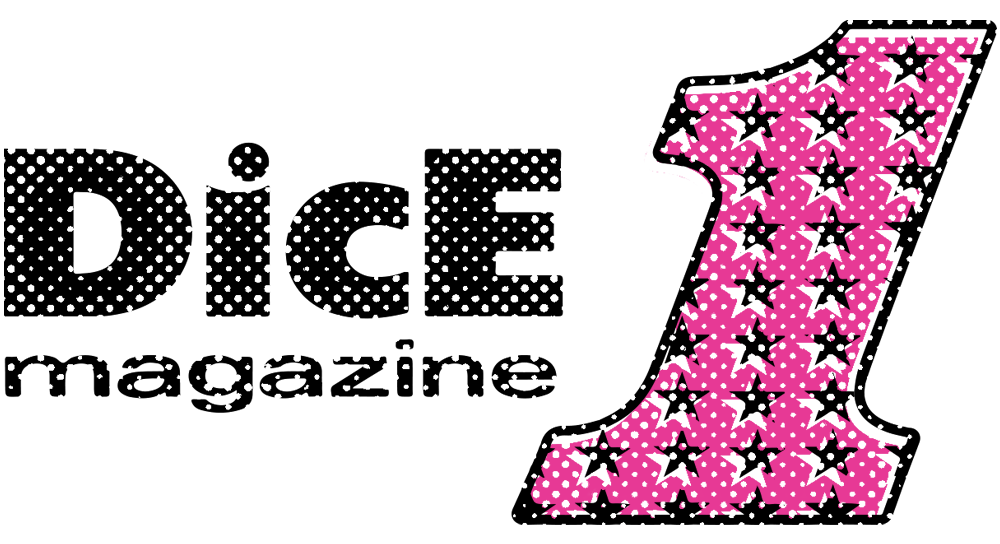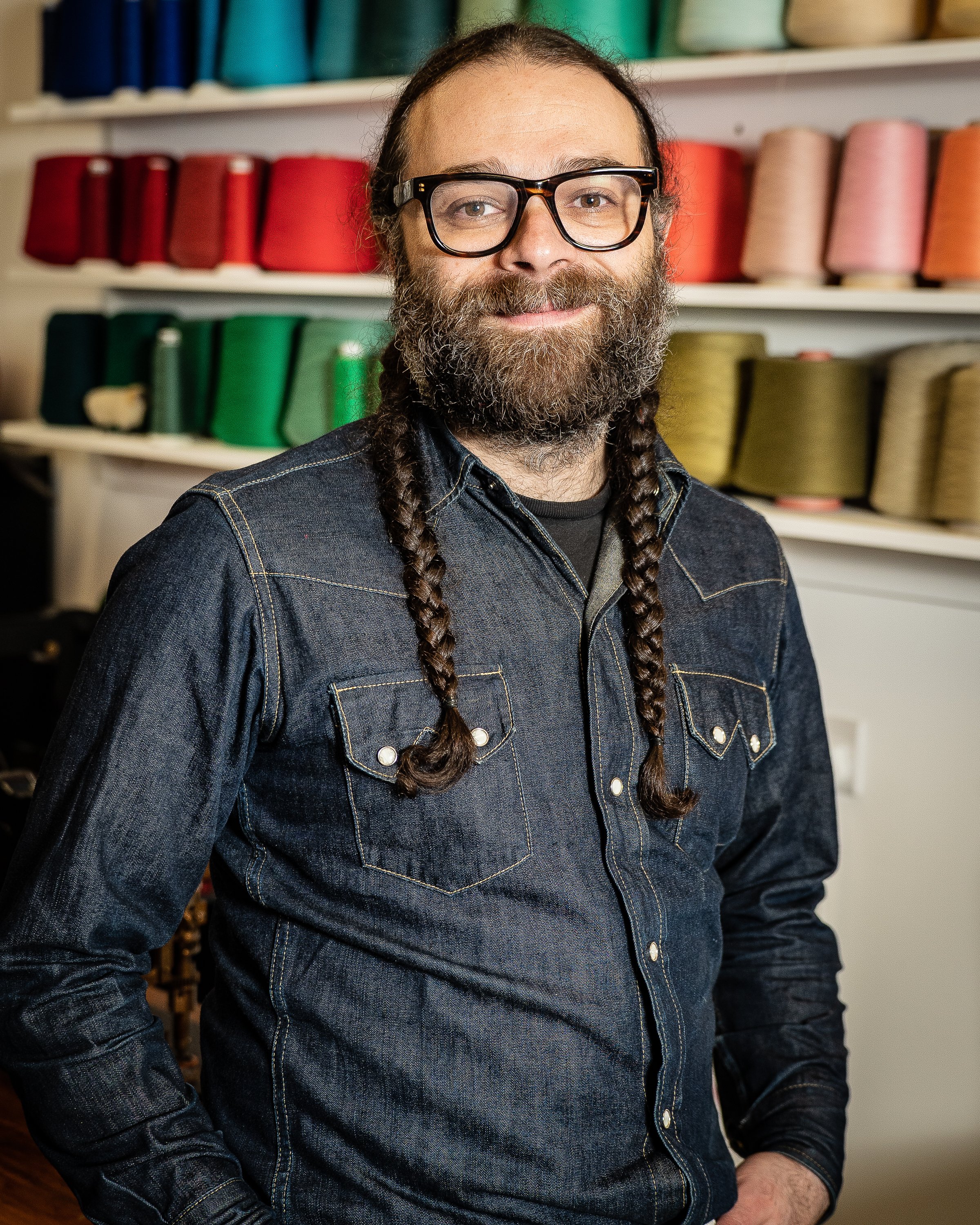Giulio Miglietta interview
Giulio Miglietta AKA the Don is a long time mate of DicE Magazine and has appeared in numerous issues including on the cover of 83 wearing some of his incredible chain stitched work. See more HERE
We are fans as much as friends so it made total sense having him work on a very special collaboration project between us and the mighty Iron Heart Denim. He will be designing a very special selection of bespoke designs and chain-stitching them onto items that will be launched in April 2023.
To be one of the first to know about the release sign up HERE
D: Hello Giulio mate, it’s lovely to have you back in our lives again and working on this very special project with us. Can you give us some details on what this collaboration is all about?
I’ve been secretly working on this for a while and am really excited for it to be launched soon! This is a very limited collection and is made up of a denim vest, a western shirt a cap and a t-shirt. Apart from the t-shirt, which has been printed in Japan, all of the pieces have unique chainstitch embroidered applications on them. These have been entirely handcrafted by myself on a beautiful 1920s chainstitch machine. The result is a unique take on the Iron Heart and Dice Magazine collaboration, in a range of wearable garments that will get better with age. All the pieces are a conversation starter, they are totally handmade and hand dyed to increase the charm and uniqueness.
The core inspiration for this capsule collection is the 1960s custom choppers culture. I’ve been a fan of this for a long time and have a great collection of printed material. With the design aspect I played with some of the classic motifs, the meanings behind them and a bit of tongue and cheek humour. Death for example, is one of the themes used back in the 50s and 60s as well as something I’ve explored in the collection. In many ways this was indeed a shock factor when portrayed on biker’s jackets, but it was also a fun aspect as well as a reminder to themselves. Stripping down motorcycles in your backyard, sometimes with little tools or knowledge to make them faster and wilder, was inevitably a major risk and buzz. It was part of the culture. It was something to laugh about and live by. Images of death were also a reminder of that particular message to those outside this culture. The message was “I live my way and society should leave me alone”. People aimed to shape up their own path; a journey that was much more individual and exposed than the safety and predictability of a 9 to 5 job, a home with a front lawn and 2.5 kids. 60 years later, many of us still feel the thrill and excitement in doing that to many extents.
D: In a world of CNC machines, laser printed 8 fin cam covers and straight to Tik Tok content why is what you do so special?
G: While I appreciate all that you mentioned for the right application, my work is just a little more old school! I work on vintage machines, just like they would have done it in the 1950s. These machines are entirely guided by my hands and I do everything by eye, without the use of computer attachments or digital support. The process is linear as well as being creative. It’s a platform to get really good results and a chance to apply your skills.
For the images side of things, I use my design experience as well as my love for storytelling and vintage aesthetics. And while the end result might be a beautiful, bespoke embroidered piece, my process has definitely got much more to it. What I do is also about building relationships with my clients, listening to them and then bring it all in embroidery form. It’s also about visual narratives, making people look good as well as creating a point of conversation to bring people together. Sometimes it’s about having a laugh, some other time is about aesthetics and other times about messages.
D: What does the process look like from your perspective?
G: It’s quite a unique process and it requires a lot of practice and muscle memory to master. The machine itself is quite rare and pretty heavy and is mounted on an industrial table. It has a multidirectional handle attached to it which is visible under the table only. This has also an on/off switch purpose and I activate it by constantly pulling it down with my right hand towards the floor. At the same time, I turn this handle around in a 360 degrees motion. This directs the stitch wherever I want. The left hand is on top of the table and takes control of the fabric, moving it around the machine needle and facilitating the stitch. Underneath the table, down on the floor there is a pedal which dictates the speed of the stitch. The result is one simple stitch that looks like a chain.
As I said before the machine is totally free motion so you can mess it up pretty quick if you are not focused. Larger lines can also be stitched but these are the results of some clever, single stitch overlapping. With the same machine I can produce chenille patches, which are common on old letterman jackets. Despite each piece being very close to each other, the method itself contributes to slight variations to the final design, making all of the pieces entirely unique!
D: What equipment do you have and is there any benefits of using these old machines?
G: All my machines do the same type of stitch, chainstitch, but I set them all up for different applications. With one I do small work only, another one is dedicated for chenille patches; my rarest one is a post-bed machine and is used for difficult applications like hats, jacket sleeves and trousers legs. For this collaboration I used my Cornely “L” model from the 1920s. It’s one of my favorites and it works so well. The machine belonged to embroidery legend, Diana Springall. Diana, at that time 86 year old, one day emailed me out of the blue, “I’ve seen your feature in Embroidery Magazine” she wrote, “I’d like you to have my machine. I’ve had it for 46 years”. I went to visit her, we had tea and fruitcake and this wonderful machine came home with me. It has much more value to it because of this. I really, deeply treasure it.
While there are a small number of new brands manufacturing these types of machines, vintage machines normally work much better. They are much smoother, predictable and enjoyable to work with. There is no way that modern machines will last half as long as the old ones. They are just not built as well; they have weaker and more porous materials and they are not constructed as well.
D: Where do you get your inspiration for the designs?
G: My best design inspirations often come from vintage findings. I have tons of early chopper mags, advertising, badges, patches, embroidered garments and ephemeras. The process normally works like this; If I’m working on a new project, I might dig out a relevant vintage piece from my archive. Rather than treating this as a literal design inspiration, I dive deep into all its aspects. Inspiration for me consists in dissecting my research object, breaking it down and extracting as many elements that might be relevant to my current project. There’s a lot of reverse engineering with what I do! I try and pull out its context, I analyse the moment in time when the piece was created, I link it to the type of language used back then as well as the visual style and complexity. I then let all those rules inform my new design piece. It’s a methodical process and while it sounds quite structured, it leaves me plenty of room for being creative. With all the elements I create a new language. All aspects are important to inform my work and not faking the funk! I love working this way.
D: How do our readers find you on the internet?
G: I’m on instagram @g_miglietta and my website is www.giuliomiglietta.com.
I focus on creating bespoke pieces and limited-edition collaborations. I also occasionally organise pop-up events at my studio where clients can come visit and get something quick made. If you are interested those are best ways to start a conversation!
Sign up to find out when the items will release HERE














